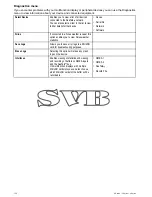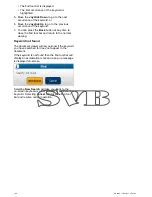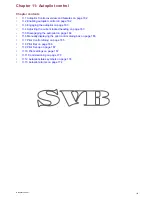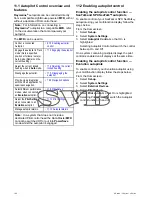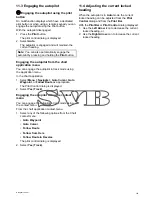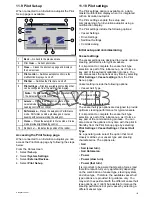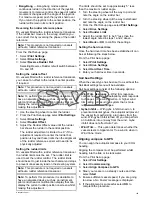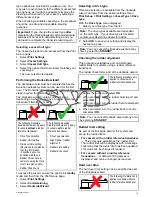
•
Bang-Bang
— Bang-bang modes applies
continuous rudder in the direction of the joystick
movement, to improve control, the speed of rudder
movement changes with the angle of the joystick.
For maximum speed, push the joystick hard over.
If you return the joystick to the center position, the
rudder will remain in its current position.
Reversing the rudder reference phase
On vessels fitted with a rudder reference transducer,
if the rudder bar moves in the wrong direction you
can correct this by reversing the phase of the rudder
reference.
Note:
This procedure is not required on vessels
without a rudder reference transducer.
From the Pilot Set-up page:
1. Select
Pilot Settings
.
2. Select
Drive Settings
.
3. Select
Reverse Rudder Ref
.
Selecting Reverse Rudder ref will switch between
On and Off.
Setting the rudder offset
On vessels fitted with a rudder reference transducer,
you can set an offset to the rudder’s center position
if required.
Note:
This procedure is not required on vessels
without a rudder reference transducer.
Note:
To perform this procedure it is desirable to
have a networked device such as an instrument,
pilot control head or multifunction display that can
display the current rudder position onscreen whilst
making this adjustment.
1. Use the steering wheel to center the rudder.
2. From the Pilot Set-up page select
Pilot Settings
.
3. Select
Drive Settings
.
4. Select
Rudder Offset
.
5. Adjust the Rudder Offset value until the rudder
bar shows the rudder in the central position.
The rudder adjustment is limited to ± 9° if the
adjustment required to center the rudder bar
position is beyond these limits then the alignment
of the rudder reference sensor will need to be
physically adjusted.
Setting the rudder limits
On vessels fitted with a rudder reference transducer
the rudder limits must be set. The rudder limit is
used to set the rudder control. The rudder limits
should be set to just inside the mechanical end stops
to prevent unnecessary load on the steering system.
Note:
This procedure is not required on vessels
without a rudder reference transducer.
Note:
To perform this procedure it is desirable to
have a networked device such as an instrument,
pilot control head or multifunction display that can
display the current rudder position onscreen whilst
making this adjustment.
The limits should be set to approximately 5° less
than the maximum rudder angle.
1. Turn the steering wheel all the way to port and
note the angle on the rudder bar.
2. Turn the steering wheel all the way to starboard
and note the angle on the rudder bar.
3. From the Pilot Set-up page select
Pilot Settings
.
4. Select
Drive Settings
.
5. Select
Rudder Limit
.
6. Adjust the rudder limit to be 5° less than the
lowest angle noted in steps 1 and 2 above.
7. Select
Back
or
OK
to confirm the settings.
Setting the hard over time
Once the hard over time has been established it can
be set following the steps below.
From the Pilot Set-up page:
1. Select
Pilot Settings
.
2. Select
Drive Settings
.
3. Select
Hard Over Time
.
4. Enter your hard over time in seconds.
Sail boat Settings
When the vessel type has been set to a sail boat the
Sail Boat settings menu will be available.
Sail boar settings consist of the following options:
•
Wind Trim Response
— Wind trim response
controls how quickly the autopilot system responds
to changes in the wind direction. A higher wind
trim setting will result in a system that is more
responsive to wind changes.
•
Gybe Inhibit
— With gybe inhibit turned on, to
prevent accidental gybes, the autopilot will prevent
the vessel from performing a turn away from the
wind. With gybe inhibit turned off, you can perform
an AutoTack into or away from the wind. Gybe
inhibit does not effect Auto Turn.
•
Wind Trim
— This option determines whether the
vessel steers to Apparent or True wind in when in
Wind Vane mode.
Aligning compass to GPS
You can align the autopilot compass to your COG
heading.
Aligning the compass must be performed whilst
heading into the tide or in slack water.
From the Pilot Set-up page:
1. Select
Pilot Settings
.
2. Select
Commissioning
.
3. Select
Align Compass to GPS
.
4. Steer your vessel on a steady course and then
select
Start
.
5. Ensure sufficient vessel speed, if you are going
too slow a ‘Go Faster’ message is displayed.
6. If the alignment is successful select
OK
to
complete the procedure.
Autopilot control
169
Содержание c125
Страница 2: ......
Страница 14: ...14 a Series c Series e Series ...
Страница 41: ...13 GPS receiver 14 Thermal camera 15 Wireless connection Planning the installation 41 ...
Страница 48: ...48 a Series c Series e Series ...
Страница 80: ...80 a Series c Series e Series ...
Страница 118: ...118 a Series c Series e Series ...
Страница 184: ...184 a Series c Series e Series ...
Страница 185: ...Chapter 13 Man Overboard MOB Chapter contents 13 1 Man overboard on page 186 Man Overboard MOB 185 ...
Страница 188: ...188 a Series c Series e Series ...
Страница 191: ...Chapter 15 Fuel manager Chapter contents 15 1 Fuel manager overview on page 192 Fuel manager 191 ...
Страница 206: ...206 a Series c Series e Series ...
Страница 228: ...228 a Series c Series e Series ...
Страница 290: ...290 a Series c Series e Series ...
Страница 310: ...310 a Series c Series e Series ...
Страница 340: ...340 a Series c Series e Series ...
Страница 374: ...374 a Series c Series e Series ...
Страница 422: ...422 a Series c Series e Series ...
Страница 436: ...436 a Series c Series e Series ...
Страница 462: ...462 a Series c Series e Series ...
Страница 463: ......
Страница 464: ...www raymarine com ...


